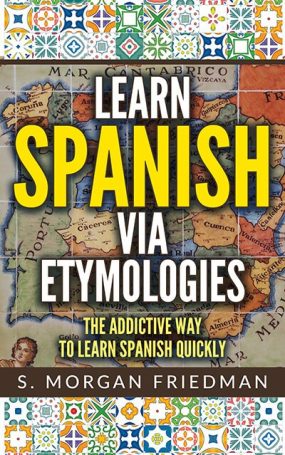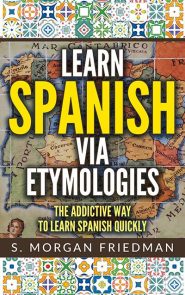Alrededor and Round
- Posted by Morgan
- on Mar 7, 2024
- in True Spanish Etymology Stories
The Spanish for “around”, alrededor”, comes from the same root as the English “round”: both come from the Latin rota, meaning, “wheel.”
The Spanish is a bit less obvious because of its al- prefix — which was originally a separate word, originally, “al rededor.” Thus, the r-(n)-d of round maps to the (al)-r-d of alrededor.
- See more of this pattern: True Spanish Etymology Stories
Cuñado and Cognate
Cuñado, Spanish for “brother-in-law,” comes from the Latin cognatus, from which we get the near-identical English cognate. How can two words so similar mean something so different?
The Latin root cognatus itself came from the roots com– (meaning “together”) and gnasci (meaning “to be born”); thus, literally, “born together.” So, two words that are cognates are — etymologically-speaking — words that are born together. And brothers-in-law are two men who are not brothers but were, in effect at least, born together as well.
Note also that this is an example of the pattern whereby Latin words with a -gn- generally became an ñ in Spanish. Thus the c-gn-t of cognate maps to the c-ñ-d of cuñado.
Libra and Deliberate and Equilibrium
- Posted by Morgan
- on Mar 5, 2024
- in True Spanish Etymology Stories
The Spanish libra (“pound”) comes from the same Latin word word, libra, meaning, “pound; balance.”
From that root, we get the English: equilibrium (literally, an “equal balance”) as well as deliberate, which literally means “to weigh carefully” (with the de– emphasis).
In Spanish, you weigh literally — but in English, metaphorically.
You can see the l-b-r root in all of the words.
- See more of this pattern: True Spanish Etymology Stories
Colgar and Collocate
- Posted by Morgan
- on Mar 4, 2024
- in True Spanish Etymology Stories
Colgar (Spanish for, “to hang”) comes from the Latin collocare — from which, unsurprisingly, we get the English, collocate. We can see the c-l-g mapping in colgar to the c-l-c root in the English and the original Latin. Hanging is really just a form of locating it!
Collocare itself comes from the prefix com– (“with”; like the Spanish con-) plus the root locare, “to place.” Thus, the word is a cousin of lugar (Spanish for “place”) and its English cousin… locate. Yes, we see the l-g map to the l-c, too. Another example of the c/g swap that we also see in colgar and collocate.
- See more of this pattern: True Spanish Etymology Stories
Cosecha and Collect
- Posted by Morgan
- on Mar 4, 2024
- in True Spanish Etymology Stories
Cosecha (Spanish for “harvest”) comes from the Latin collectus, meaning, “collected.”
This makes sense: a harvest is, well, just collected.
Although the English collected is almost identical to the Latin, we can see how the Latin changed into the Spanish: the -ll- turned into an -s-, in a curious change. But — as is more common — the -ct- became a -ch- (think nocturnal/noche or octagon/ocho). Thus, the c-ll-ct of collect maps to the c-s-ch of cosecha.
- See more of this pattern: True Spanish Etymology Stories
Puñal and Pugnacious
The English for eager-to-fight, pugnacious, contains the -gn- pattern inside it: a give-away to the pattern that -gn- words in Latin turned the -gn- into a -ñ- in Spanish yet remained the same into English.
Therefore, pugnacious maps perfectly to puñal, the Spanish for… “dagger.” It makes sense that “dagger” and “eager to fight” come from the same root, after all. And that root, in this case, is the Latin pugnare, meaning, “to fight.”
what is the etymological way to learn spanish?
Nerds love to pattern-match, to find commonalities among everything. Our approach to learning languages revolves (the same -volve- that is in “volver”, to “return”) around connecting the Spanish words to the related English words via their common etymologies – to find the linguistic patterns, because these patterns become easy triggers to remember what words mean. Want to know more? Email us and ask:
morgan@westegg.com

